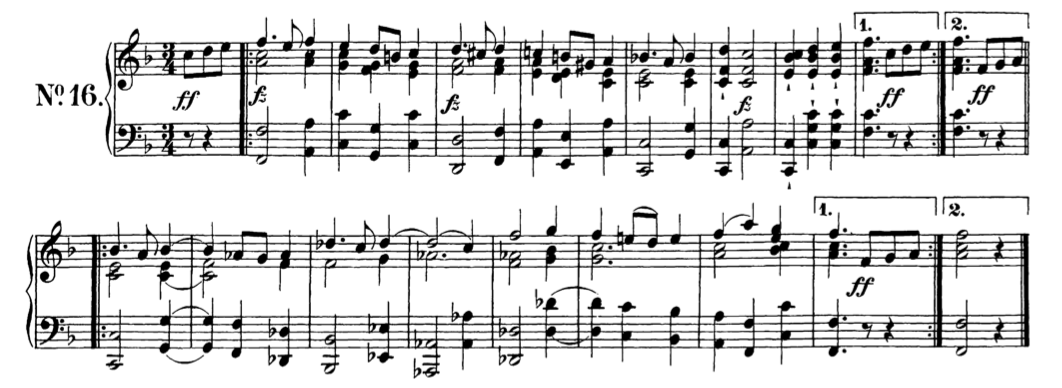There are four tests at this grade:
6A – Repeat the upper part of a melody, played twice
You will hear a key chord and then a two–bar count–in, for example 'One, two, One, two' or One, two, three, One, two, three'. Listen carefully to these because a feel for the pulse and tonality will help you to remember the melody.
Then you have to listen and repeat the melody, like an echo. The melody will be played in the right hand, in effect a tune with a simple accompaniment.
You may sing any sound, such as 'Lah lah' or you could hum or whistle if you prefer. You also have the choice of playing the melody on your instrument. If you choose to play the melody back the examiner will, of course, tell you the key chord and starting note for your instrument.
6B – Sing a melody from a printed score while the accompaniment is played
You have to sing a melody from a printed score while the examiner plays a piano accompaniment. You will hear the key chord, starting note and pulse first then you will have a short time to prepare. When you look through the test, notice any easy scale patterns and try out the leaps in pitch. You begin singing after hearing again the key chord, starting note and a two–bar count–in. Don’t wait for the piano part to lead – begin as confidently as possible, aiming to keep a steady pulse and a sense of key.
This test may feel challenging if you have never sung from a score before, but the key to improving is simply to practise doing it. Joining a choir that sings from printed music is of tremendous benefit. The E–MusicMaestro Aural Tests Training programme offers examples for you to try out, with lots of help beforehand with pitching intervals.
6C – Cadences
In this test you listen to a musical phrase and decide whether the cadence at the end is perfect or imperfect.
What is the difference between a perfect cadence and an imperfect cadence?
An imperfect cadence sounds unfinished, as if more music should follow, because it ends on Chord V, for example Chord C in the key of F.
A perfect cadence is Chord V followed by Chord I. It sounds finished because the last chord is the key chord. The Schubert German Dance in the example below is in the key of F major. It ends with a perfect cadence, a C major chord then finally an F major chord.

Listening to examples is the best way to recognise cadences and E–MusicMaestro Aural Test Training demonstrates numerous perfect and imperfect cadences, giving you practice at identifying them accurately and supplying the correct answer if you were unsuccessful.
6D – Listen and notice musical details and time recognition
You will listen to a short piece played on the piano. Afterwards you will be asked two questions. One question will be about either the Structure of the music or the Texture of the music.
The second question will be about one of the following:
- the style and period of the music
- what, in the music, gives the piece its character
- whether the music is in a major key or a minor key;
- whether speed of the music changed, or not
- loud or quiet playing
- smooth or detached notes
These are rather like the questions you will have answered at Grades 1 – 5.
What is structure in music?
Structure is how the piece is made up, for example how many phrases there are or how many main sections you hear.
Look again at the Schubert German Dance. Here is a description of its structure:
The overall structure is binary form, meaning that is the music is in two distinct, different sections that we could call Section A and Section B. Each section is repeated. Both sections are eight bars in length and all the phrases are regular, four bars long.
What is texture in music?
Texture is to do with the number of musical lines, or layers played and the relationship between them. For instance a piece could have a melody line in the top part, accompanied by chords whereas another piece might have just a single line melody in one hand with a single line in the other hand too.
Looking at the Schubert German Dance again, we could say that the texture is chordal, with the melody played in the top notes. The bass part is nearly always in octaves.
Clap the rhythm of a phrase from the piece and then say if the piece you just heard was in 2 time, 3 time or 4 time.
Once you have answered the questions you will hear a phrase from the same piece twice and then clap the rhythm back. Rhythm is not the same as pulse. Whereas pulse stays constant, rhythm patterns change. Rhythm is one of the musical elements that helps you to recognise a tune you know – try clapping the rhythm of a well known tune and you may find that someone listening can identify it!
After you have clapped the rhythm you will say if the piece was in 2 time, 3 time or 4 time. It helps if you had decided on 2 time, 3 time or 4 when you first heard the piece, but if you didn't make up your mind then, hearing the phrase to be clapped will help you.